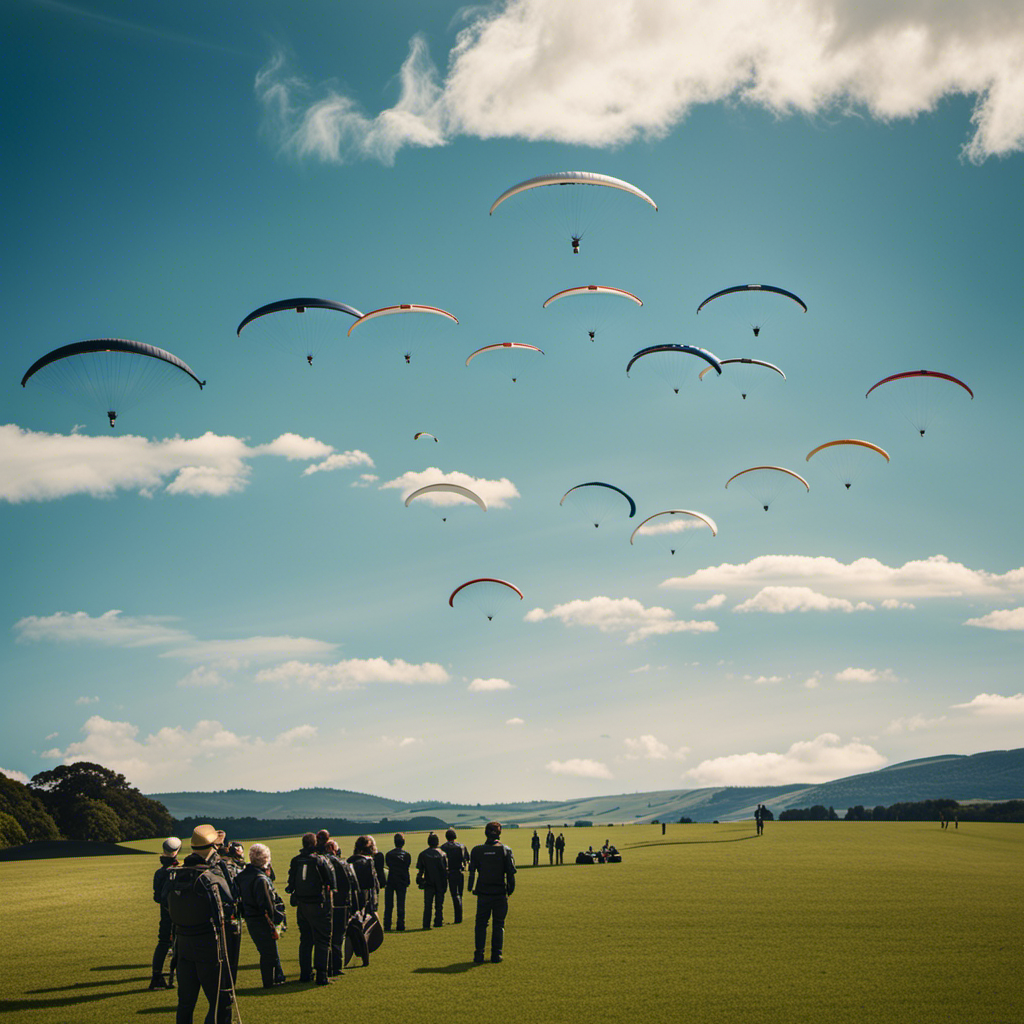Joining a gliding club is an exciting way to glide through the skies and experience the freedom of flying. I have found that being a member of a gliding club has many advantages, such as learning the fundamentals of gliding, taking part in competitions, and discovering stunning destinations.
In this article, I’ll share what you need to know about joining a gliding club, including the necessary skills, equipment, and how to find the right club for you.
So, buckle up and get ready to embark on an incredible journey into the world of gliding.
Key Takeaways
- Joining a gliding club offers the opportunity to learn from experienced gliders and fly in different locations and conditions.
- Participating in club events and competitions allows you to challenge yourself and foster camaraderie and friendship with other pilots.
- Understanding the basics of gliding, including concepts of lift, drag, and weight distribution, allows you to control speed, altitude, and direction while making informed decisions.
- Developing the necessary skills, such as launching and landing smoothly, reading weather conditions, and effectively communicating and working as a team, is crucial for a successful gliding experience.
Benefits of Joining a Gliding Club
There’s a lot of benefits to joining a gliding club. One of the main advantages is the opportunity to learn from experienced gliders. Being part of a club gives you access to a community of experienced pilots who can provide guidance and support as you learn the ropes.
Additionally, joining a gliding club opens up a world of opportunities to fly in different locations and conditions. You can participate in club events, competitions, and even go on cross-country flights.
The club environment also fosters a sense of camaraderie and friendship among fellow gliders. By joining a gliding club, you not only gain access to resources and knowledge, but you also become part of a tight-knit community that shares your passion for soaring through the skies.
Understanding the basics of gliding is crucial in order to safely and confidently navigate the world of gliding.
Understanding the Basics of Gliding
Understanding the basics of gliding is crucial before starting your journey in the club. Gliding techniques and aerodynamics principles form the foundation of this exhilarating sport.
Gliding involves flying without the use of an engine, using natural air currents to stay aloft and maneuver the aircraft. To glide effectively, you need to master concepts such as lift, drag, and weight distribution.
Learning how to control the glider’s speed, altitude, and direction is essential. By understanding how the wings generate lift and the forces acting on the aircraft, you can make informed decisions while flying.
Developing the necessary skills in gliding requires practice and experience. Through guided instruction and hands-on training, you will gradually build confidence in your abilities and become proficient in the art of gliding.
Developing the Necessary Skills
To develop the necessary skills in gliding, you’ll have to practice and gain experience through guided instruction and hands-on training. Developing practical skills and honing techniques is essential for becoming proficient in gliding. Here are a few key things to focus on:
- Mastering the art of launching and landing smoothly
- Learning how to read the weather conditions and make informed decisions
- Practicing proper communication and teamwork with other pilots
- Improving your ability to navigate and control the glider effectively
By continuously practicing and refining these skills, you will become more confident and capable in the world of gliding.
Once you have developed your skills, the next step is to ensure you have the right equipment to support your gliding adventures.
Getting the Right Equipment
Make sure you have the appropriate equipment for gliding by researching and investing in high-quality gear. Choosing the right equipment is crucial to ensure a safe and enjoyable gliding experience.
When it comes to proper gear selection, there are a few key items you’ll need. First and foremost, a glider is essential. Look for a glider that suits your skill level and flying goals. Additionally, you’ll need a parachute for emergencies, a headset for clear communication, and a variometer to help you navigate and maintain the glider’s optimal speed. It’s also important to invest in a good pair of flying boots and comfortable clothing that allows for unrestricted movement.
By having the right equipment, you’ll be well-prepared for your gliding adventures.
Now, let’s move on to finding a gliding club where you can put this gear to use.
Finding a Gliding Club
When it comes to finding a gliding club in your area, there are several key points to consider.
The first step is to conduct thorough research and locate the clubs that are available nearby.
Once you have a list of potential clubs, it’s important to visit and assess each one to determine which club best suits your needs and preferences.
Researching and Locating Gliding Clubs in Your Area
Before you start looking for gliding clubs in your area, it’s important to do thorough research to find the best options available. Researching clubs and selecting the right one for you requires careful consideration. To make this process easier, I have created a table below that outlines some key factors to consider when evaluating different gliding clubs:
| Factors to Consider | Description |
|---|---|
| Location | Is the club conveniently located? |
| Facilities | What kind of facilities does the club offer? |
| Membership Fees | How much does it cost to become a member? |
| Training Programs | What kind of training programs does the club provide? |
| Safety Record | How does the club prioritize safety? |
Visiting and Assessing Different Clubs
After researching and locating gliding clubs in my area, the next important step is to visit and assess the different clubs. This allows me to get a firsthand experience of the facilities and evaluate the membership benefits offered.
When visiting a gliding club, I pay close attention to the condition of their hangar and runway. Are they well-maintained and safe? I also look at the available gliders and equipment, ensuring they are in good working order. Additionally, I evaluate the club’s training program and instructor availability, as these factors greatly impact my learning experience.
Furthermore, I take note of the club’s social atmosphere and community involvement, as being part of a supportive and active club can enhance my overall enjoyment of gliding. By thoroughly assessing these aspects, I can make an informed decision about which club best suits my needs and interests.
Transitioning into the next section, let’s delve into the process of joining and becoming a member of a gliding club.
Joining and Becoming a Member of a Gliding Club
To become a member of a gliding club, it’s important to understand the membership requirements and the benefits that come with joining. The joining process typically involves submitting an application, paying membership fees, and attending an orientation session. Once you become a member, you gain access to a range of benefits that make the experience truly rewarding.
- Emotion-evoking benefits:
- Sense of belonging: Being part of a gliding club creates a strong sense of community and camaraderie. You’ll meet like-minded individuals who share your passion for flying.
- Thrilling experiences: Gliding offers an exhilarating experience as you soar through the sky, feeling the wind rush past you and witnessing breathtaking aerial views.
- Practical benefits:
- Access to gliders and facilities: As a member, you’ll have access to a fleet of gliders and state-of-the-art facilities, including hangars, workshops, and briefing rooms.
- Training and support: Gliding clubs provide training programs and experienced instructors to help you develop your skills and achieve your goals.
Training and Certification Process
When it comes to training and certification in gliding, there are several key points to consider.
First, ground school and theoretical knowledge play a crucial role in understanding the principles of flight and gliding techniques.
Second, flight training and practical skills assessment are essential for developing the necessary skills and gaining hands-on experience in the cockpit.
Ground School and Theoretical Knowledge
Before you can begin flying, you’ll need to complete the ground school and gain theoretical knowledge.
The ground school curriculum covers important topics such as aerodynamics, meteorology, navigation, and glider operations. It provides you with the necessary foundation to understand the principles and concepts of gliding.
Once you have completed the ground school, you will be required to take a theoretical knowledge examination to test your understanding of the material. This examination evaluates your knowledge and ensures that you are ready to apply it in practical situations during flight training.
After successfully passing the examination, you can move on to the next phase of your training: flight training and practical skills assessment. This is where you will learn how to apply the theoretical knowledge you have gained in real-world flying scenarios.
Flight Training and Practical Skills Assessment
After completing my ground school and theoretical knowledge training, it was time to move on to the next phase of my gliding journey: flight training and practical skills assessment. This is where the real fun begins! To prepare for actual flying, I first underwent flight simulator training. This allowed me to familiarize myself with the controls and practice basic maneuvers in a simulated environment. Once I felt comfortable, I progressed to the real thing – glider aerobatics. This exhilarating experience involved performing a series of precision maneuvers such as loops, spins, and rolls under the guidance of a skilled instructor. The table below provides an overview of the key skills I learned during this phase of training:
| Skills | Description |
|---|---|
| Pre-flight checks | Thoroughly inspecting the glider before each flight to ensure its airworthiness |
| Takeoff and landing | Proper technique for a smooth and safe takeoff and landing |
| Straight and level flight | Maintaining a steady altitude and heading during flight |
| Turns and banked flight | Executing coordinated turns and maintaining a constant bank angle |
| Emergency procedures and safety | Reacting appropriately in emergency situations and prioritizing safety |
With these skills under my belt, I was ready to take the next step in my gliding journey: obtaining gliding licenses and ratings.
Obtaining Gliding Licenses and Ratings
To obtain gliding licenses and ratings, it’s important to demonstrate proficiency in a variety of skills. These skills include pre-flight checks, takeoff and landing techniques, straight and level flight, turns and banked flight, as well as emergency procedures and safety measures.
The training process for obtaining these licenses involves both theoretical and practical components. In the theoretical aspect, aspiring glider pilots must study topics such as aerodynamics, meteorology, navigation, and aviation regulations. They also need to pass written exams to assess their knowledge in these areas.
On the practical side, pilots-in-training undergo flight training where they apply their theoretical knowledge in real-world scenarios. They are assessed on their ability to safely operate the glider and handle different flight conditions.
By successfully completing the training process and demonstrating their skills, pilots can obtain licenses and ratings that certify their proficiency in gliding. This ensures that they have the necessary knowledge and competence to safely engage in glider flights.
Moving forward, it is important to also focus on safety and risk management to ensure a safe and enjoyable gliding experience.
Safety and Risk Management
In this discussion, I’ll be exploring the important topic of safety and risk management in gliding. We’ll delve into three key points:
- Understanding and mitigating risks in gliding.
- Emergency procedures and contingency planning.
- Regular maintenance and inspections.
Understanding and Mitigating Risks in Gliding
Understanding and mitigating risks in gliding is essential for a safe and enjoyable experience. Before taking to the skies, a thorough risk assessment must be conducted. This involves evaluating factors such as weather conditions, aircraft maintenance, and pilot experience. Safety protocols should be in place to address potential hazards. These protocols may include pre-flight inspections, regular training sessions, and adherence to established procedures.
By implementing these measures, the likelihood of accidents or incidents can be significantly reduced. However, even with the best risk management practices, emergencies can still occur. Therefore, it is crucial to have comprehensive emergency procedures and contingency planning. This ensures that pilots are prepared to handle unexpected situations and can respond swiftly and effectively.
Transitioning to the next section, let’s explore the importance of emergency procedures and contingency planning in gliding.
Emergency Procedures and Contingency Planning
Make sure you familiarize yourself with the emergency procedures and contingency planning in order to be prepared for any unexpected situations while gliding.
Emergency response is a critical aspect of gliding, as it ensures the safety of both the pilot and the aircraft. Gliding clubs regularly conduct emergency drills to practice and reinforce these procedures.
During these drills, pilots learn how to handle different emergency scenarios such as loss of control, engine failure, or mid-air collisions. They are trained to make quick and decisive decisions to ensure the safety of everyone involved. These drills help pilots develop the necessary skills and confidence to handle emergencies effectively.
By being well-prepared and knowledgeable about emergency procedures, pilots can mitigate potential risks and respond promptly in case of an emergency. This emphasis on emergency response is just one aspect of ensuring a safe gliding experience.
Transitioning into the subsequent section about regular maintenance and inspections, it is important to maintain the highest standards of maintenance to minimize the risk of mechanical failures and ensure the continued airworthiness of the gliders.
Regular Maintenance and Inspections
To ensure the continued airworthiness of your glider, it’s crucial to regularly maintain and inspect the aircraft. Here are some key steps to follow for regular maintenance and inspection procedures:
- Perform pre-flight inspections before every flight to check for any visible damage or issues.
- Follow the manufacturer’s recommended maintenance schedule and complete all necessary tasks, such as lubricating moving parts and checking fluid levels.
- Keep a detailed logbook to track maintenance activities, including inspections, repairs, and component replacements.
Conduct thorough inspections of critical components, such as the wings, control surfaces, and landing gear, to ensure they are in good condition.
- Regularly inspect and maintain the glider’s instruments and avionics to ensure accurate readings and proper functionality.
By consistently following these maintenance and inspection procedures, you can help ensure the safety and airworthiness of your glider.
Now, let’s move on to the exciting world of participating in gliding competitions and events.
Participating in Gliding Competitions and Events
If you’re interested in participating in gliding competitions and events, it’s important to familiarize yourself with the rules and regulations.
Gliding competitions require strategic planning and execution to achieve success. One key strategy is to thoroughly understand the competition format and rules, as this will help you make informed decisions during the event.
Additionally, it’s crucial to have a good understanding of the weather conditions and how they might affect your flight. Developing effective communication skills with your team and fellow competitors is also vital.
Participating in gliding events is a great way to improve your skills and gain valuable experience. By actively engaging in these competitions, you’ll have the opportunity to challenge yourself and learn from other experienced gliders.
Exploring Gliding Destinations
After experiencing the exhilaration of gliding competitions and events, it’s time to explore the world of gliding tourism and discover popular gliding destinations.
Whether you’re looking for breathtaking mountain views or serene coastal landscapes, there are plenty of places that cater to gliding enthusiasts like myself. Here are some of the top destinations to consider:
- The Swiss Alps: With its stunning peaks and valleys, the Swiss Alps offer a perfect backdrop for gliding adventures.
- New Zealand: Known for its diverse landscapes, New Zealand provides a unique gliding experience, from soaring over lush forests to gliding along rugged coastlines.
- Namibia: The vast deserts and open plains of Namibia offer an unparalleled sense of freedom and endless opportunities for gliding.
- Patagonia, Argentina: With its dramatic scenery and strong thermals, Patagonia is a dream destination for gliders seeking thrilling flights.
As I continue to explore gliding destinations around the world, I am also eager to delve into the realm of continuing education and advancement in gliding.
Continuing Education and Advancement in Gliding
When it comes to advancing in the world of gliding, there are several key points to consider.
First, further training and advanced techniques are crucial for improving your skills and becoming a more proficient glider pilot.
Second, pursuing instructor and coaching certifications can open up new opportunities for teaching and sharing your knowledge with others.
Lastly, engaging in continuous learning and skills development is necessary to stay up-to-date with the latest advancements and techniques in the field of gliding.
Further Training and Advanced Techniques
To progress in your gliding skills, it’s important to seek further training and learn advanced techniques. Here are three ways you can enhance your gliding abilities through specialized training:
- Advanced Flight Maneuvers: Take courses that focus on advanced techniques such as thermaling, ridge soaring, and cross-country flying. These skills will help you navigate challenging weather conditions and maximize your flight performance.
- Instrument Flying: Learn how to fly using instruments, which is crucial for flying in low visibility or at night. This training will teach you to rely on your instruments for navigation and control, making you a more confident and versatile pilot.
- Aerobatics Training: If you’re looking for an adrenaline rush, consider pursuing aerobatics training. This will teach you how to perform thrilling maneuvers like loops, rolls, and spins, pushing your flying skills to the limit.
Pursuing Instructor and Coaching Certifications
If you’re interested in becoming a gliding instructor or coach, it’s essential to obtain the necessary certifications. Instructor training and coaching qualifications are crucial for ensuring that you have the knowledge and skills to effectively teach and guide others in the sport of gliding.
To become a gliding instructor, you will need to complete a certified instructor training program, which includes both theoretical and practical components. This training will cover topics such as flight instruction techniques, safety procedures, and regulatory requirements.
Additionally, pursuing coaching qualifications will provide you with the expertise to mentor and develop the skills of gliding athletes. By obtaining these certifications, you will be equipped to share your passion for gliding and help others achieve their goals in the sport.
Transitioning to the next section, engaging in continuous learning and skills development is also important for staying current and improving as an instructor or coach.
Engaging in Continuous Learning and Skills Development
By actively seeking out new training opportunities and regularly expanding my knowledge and skills, I can stay up-to-date and continue to grow as an instructor or coach in the field of gliding.
Continuous improvement and skill enhancement are essential for providing the best instruction and guidance to gliding club members.
One way to achieve this is by attending workshops and seminars specifically designed for gliding instructors. These events offer valuable insights, updates on industry standards, and opportunities to learn from experienced professionals.
Additionally, participating in mentorship programs allows me to gain guidance and feedback from more experienced instructors.
Another valuable resource is online courses and webinars, which provide flexibility and convenience for continuing education.
Frequently Asked Questions
How much does it cost to join a gliding club?
Joining a gliding club can have various cost considerations. Membership benefits often include access to gliders, instruction, and social events. It’s important to research specific clubs to determine their fees and what is included in membership.
Are there any age restrictions for joining a gliding club?
Yes, there may be age restrictions when joining a gliding club. However, the benefits of joining include learning to fly, meeting fellow aviation enthusiasts, and being part of a supportive community.
Can I bring my own glider to a gliding club?
Yes, you can bring your own glider to a gliding club. However, it is important to note that joining requirements may vary and some clubs may have their own equipment available for use.
Are there any health requirements to participate in gliding?
Yes, there are health restrictions for gliding. Participants must meet certain medical conditions to ensure their safety. It is important to consult with a doctor to determine if you are fit to participate in this activity.
Can I participate in gliding if I have no prior flying experience?
Yes, it is possible to participate in gliding without prior flying experience. Gliding clubs provide training for beginners, teaching you the necessary skills and knowledge to safely enjoy the sport.
Conclusion
In conclusion, joining a gliding club is like entering a whole new world of exhilaration and adventure. The benefits are endless. From experiencing the thrill of soaring through the sky to developing skills that will last a lifetime.
With the right equipment and a supportive club, you’ll be able to explore breathtaking destinations and even compete in thrilling competitions. Safety is always a top priority, ensuring your well-being while you indulge in this extraordinary sport.
So why wait? Join a gliding club today and let your dreams take flight!
Orion, better known as “Jetstream,” is the voice that brings the stories of the skies to life. His fascination with aviation began at a young age, sparked by his father’s tales of flying and adventure. Orion’s journey into the world of gliding was serendipitous, and from the moment he took his first glider flight, he knew he had found his calling.










